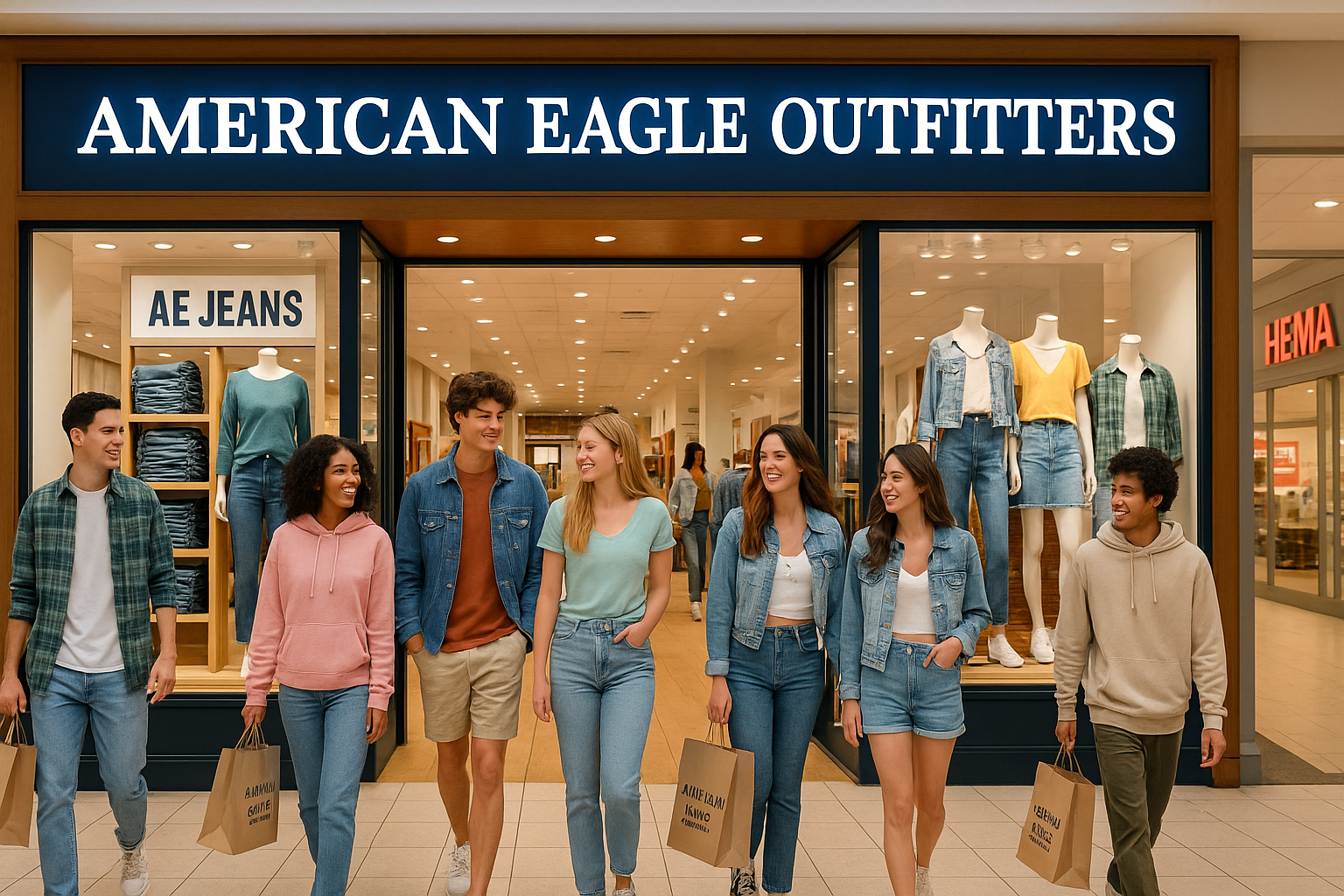
American Eagle Outfitters, Inc. (NYSE:AEO) has carved a unique niche in the American fashion landscape, rising from humble beginnings as a small family-owned denim retailer to become a multi-billion-dollar youth apparel powerhouse. The company’s journey mirrors the shifting tides of American consumer tastes, retail innovation, and the enduring appeal of denim as a cultural staple.
Founding Years: The Seeds of a Brand
American Eagle Outfitters traces its origins to 1977, when brothers Jerry and Mark Silverman, who were then running Silvermans Menswear, launched the first American Eagle store in Novi, Michigan. Their vision was clear: to create a specialty store catering to young adults with a focus on rugged, outdoor-inspired clothing and, above all, denim. This new concept was designed to complement the family’s existing retail operations, but quickly took on a life of its own.
Throughout the late 1970s and 1980s, American Eagle expanded cautiously, emphasizing quality and versatility. Its offerings included jeans, flannel shirts, boots, and outdoor gear—products that appealed to the emerging “preppy” trend among American youth.
1990s: Reinvention and Explosive Growth
By the early 1990s, American Eagle Outfitters faced new challenges as competition intensified and consumer tastes evolved. Recognizing the need for a fresh approach, the Silverman family sold the company to Retail Ventures, Inc., a subsidiary of Schottenstein Stores Corp., led by Jay Schottenstein. This transition marked a turning point. The new management, under Schottenstein’s leadership, refocused the brand squarely on casual wear for teens and young adults, honing in on denim as the cornerstone of its identity.
This strategy paid off dramatically. Through the 1990s, American Eagle Outfitters rapidly expanded its footprint across malls in the United States, riding the wave of mall culture and the boom in teen spending. The company developed a distinctive brand voice—authentic, all-American, and aspirational—while keeping price points accessible.
In 1994, the company went public, trading on the New York Stock Exchange under the symbol NYSE:AEO. This capital infusion fueled even more ambitious growth, and by the decade’s end, American Eagle Outfitters had become synonymous with youthful American style.
2000s: Innovation and Adapting to a New Era
The turn of the century brought both opportunities and fresh challenges. The collapse of the dot-com bubble and shifts in retail trends tested even the strongest brands. American Eagle Outfitters responded with strategic diversification. The company expanded into new segments, launching aerie, a lingerie and activewear brand, in 2006, which quickly gained traction with a focus on body positivity and inclusivity.
Simultaneously, American Eagle Outfitters strengthened its e-commerce presence, understanding that the future of retail would be shaped by digital innovation. Store designs were refreshed to maintain relevance in an evolving marketplace, while denim remained the backbone of the product line.
During this time, the brand also expanded internationally, entering markets in Canada, Mexico, and the Middle East. The global reach provided new growth avenues and diversified revenue streams.
2010s: Navigating Fashion Cycles and Digital Disruption
The 2010s ushered in a new era defined by rapid fashion cycles, the rise of social media, and unprecedented competition from fast-fashion giants. American Eagle Outfitters maintained its edge by emphasizing quality, affordability, and authenticity. The aerie brand, in particular, became a major growth driver, winning over Gen Z consumers with its no-retouching advertising and real-person models.
To stay ahead, the company invested in technology, launching mobile apps and embracing data-driven decision-making. American Eagle Outfitters also revamped its denim lines to keep pace with evolving styles, from skinny jeans to high-waisted and relaxed fits.
This decade also saw the brand face off against new challengers like Abercrombie & Fitch (NYSE:ANF) and international fast-fashion chains. American Eagle Outfitters responded with agility, focusing on its core strengths and continuously refining its brand identity.
2020s: Resilience Through Uncertainty and Reinvention
The COVID-19 pandemic presented a monumental test for the entire retail industry. With physical stores shuttered and consumer behavior in flux, American Eagle Outfitters accelerated its digital transformation. The company leaned heavily into curbside pickup, expanded digital fulfillment, and optimized its supply chain to respond to new realities.
Despite the turbulence, the company’s strong online presence and loyal customer base helped it weather the storm better than many peers. The aerie brand continued to flourish, and the company introduced new sub-brands and collaborations to stay at the cutting edge of youth fashion.
Today, American Eagle Outfitters, Inc. is recognized as an enduring icon in youth retail, balancing its denim heritage with a dynamic, digital-first approach. With hundreds of stores globally and a thriving online business, the company remains a staple in the closets of American teenagers and young adults. Its story is one of adaptability, brand clarity, and a keen understanding of its audience—a testament to decades of strategic pivots and bold decisions.
Disclaimer: This article is for informational purposes only and does not constitute financial advice. Investors should conduct their own research or consult a financial advisor before making investment decisions.
